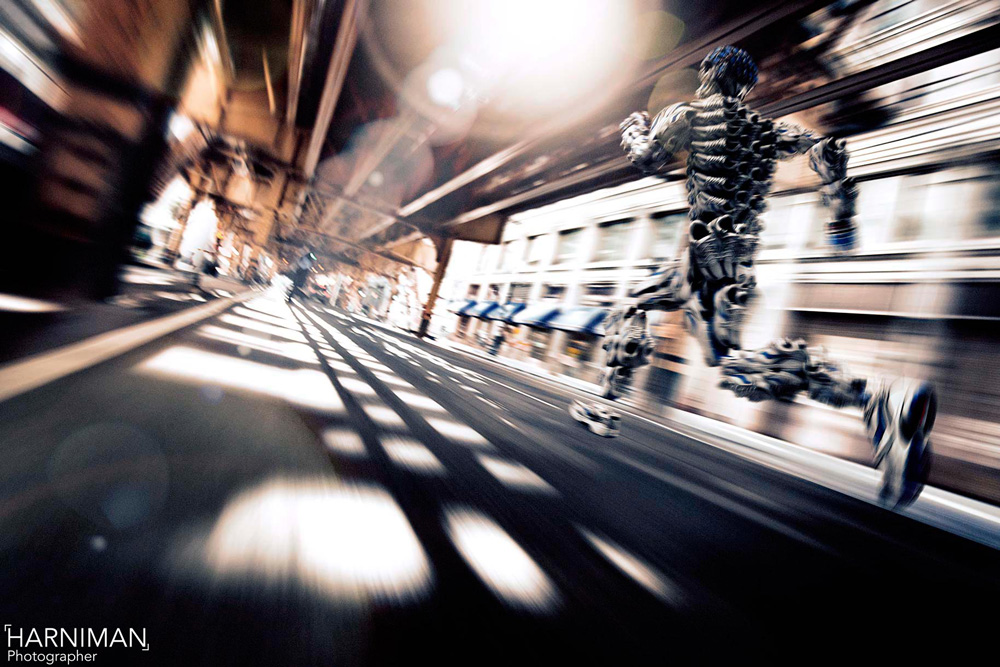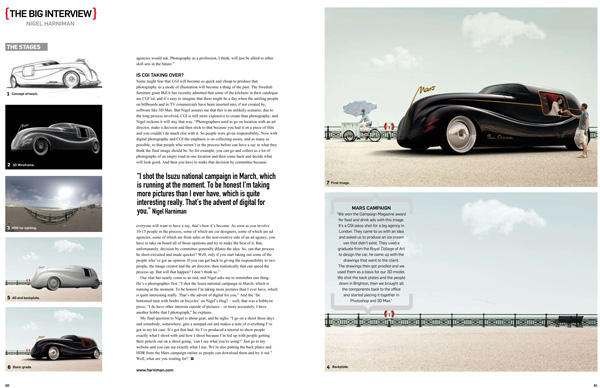Blog

My big Interview in Professional Photographer Magazine: True Lies, Part 2
Before CGI
A photographer at heart, Nigel’s career started in London where he looked for the biggest photographers he could find doing location photography and tried to get work experience with them. “There were loads of people I tried to get work with at the time such as Alan Brooking, who did the iconic 1970s pictures of a pregnant man. Then I started working with a guy called Jake Wallis, doing location guides, and later on I worked with Chris Simpson, we travelled around shooting location pictures.”
The work with Chris Simpson led to Nigel taking pictures of a Ford Galaxy, which gave him some ad work to put in his portfolio. Then the computer generated part of his work came about, around eight years ago. “There was this thing on the horizon called CGI that people were talking about it in LA and London, and various other places. That was at the early stages and everyone was saying ‘this is absolutely marvellous’. It wasn’t really ready to go, but I thought okay, we’ll get on board and find out about the processes. It was real cutting-edge and I was banging my head against the wall trying to make things work. We did a load of testing, went to see a lot of clients, picked up a few. A few people were very anti it at the time, they didn’t really understand it, but then one thing led to another.”
By that Nigel means the long list of expensive cars that have been added to his CGI portfolio and the awards he has won for the quirky, chocolate-shaped ice cream van he created for the Mars advertising campaign. But despite seemingly having secured a livelihood, Nigel is hesitant to agree that he has carved a safe niche. “I’m totally comfortable with my skills at the moment, but I think the issue with image production right now, regardless of whether it be CGI or photography, is that there is an oversupply in every area. And why is that? Well, digital made photographs very easy to take so there was an explosion in the availability of stock images. You can get stock images for virtually no money now, just like it happened in the music industry. The parallels are quite scary, really. And the CGI content, well, there’s thousands of people wanting to go and work on Avatar and they all come out of college thinking they are going to go?and work on the next big film, so again there’s oversupply in that market.”
Global demand
As well as the competition from computer-savvy graduates, globalisation has had an effect on the way car photographers are hired. Years ago, Nigel tells me, images for the UK market would be produced in the UK, supporting around 50 to 60 top-end car photographers. One company, which Nigel prefers not to name, then moved their image production to a place in central Europe, and then from there to Japan, leaving the UK car photographers to pursue other work. But it’s the same effect of globalisation that secured Nigel his lush contract with Volvo. “The Volvo images we produced for their CGI campaign were used around the world. 21 images, which was pretty much all Volvo needed to launch their C30 three years ago, and one person has done them – years ago there’d be lots of different people working with different agencies producing those images around the world. That’s how it’s contracted. It’s not just the fault of CGI, it’s the fault of many, many factors that have caused the collapse of the photographer’s day rate and the demand for the photographer.”
At a time when everybody is talking about convergence and we’ve been asking photographers, art buyers and picture editors whether the still image is becoming part of a much larger multimedia package a photographer is expected to provide, it seemed natural to pose the big question to Nigel:
Is the still photograph being replaced by the moving image?
“It’s very interesting because everybody jumped on shooting videos as soon as the 5D came out and yes, clients are asking for video, but they are only asking photographers to do it because they don’t want to pay the big bucks for the production companies to do it. So the answer to your question is yes, but it’s all about reducing costs, it’s not about creativity. Proper creativity costs; thought time, production time… so clients look at photographers and say ‘let’s do without the big production company, let’s do without the big producer’ – can the photographer be the producer and the art director? And in some cases it works well, in other cases it falls short.”
Conversely, Nigel mingles with many art directors who are moving into photography in what seems to be a giant, muddled multimedia pool. “To say photographers need to broaden their skill sets, I don’t think it’s just photographers who need that. Art directors and CGI artists have broadened their skill sets, everybody has. And I think photography will eventually just be part of another job. You may have trained as a graphic artist and be an art director and also have a good understanding of Photoshop and photography, so you can supply the images. Art directors may be interviewed in the future and be asked ‘what’s your photography like?’ And perhaps to get the job you have to have photography as a large portion of your skill set. But I can’t see people wanting to employ photographers and asking them, ‘by the way, can you do some art direction?’ – that doesn’t sit in my head as a natural question ad agencies would ask. Photography as a?profession, I think, will just be allied to other skill sets in the future.”
Is CGI taking over?
Some might fear that CGI will become so quick and cheap to produce that photography as a mode of illustration will become a thing of the past. The Swedish furniture giant IKEA has recently admitted that some of the kitchens in their catalogue are CGI’ed, and it’s easy to imagine that there might be a day when the smiling people on billboards and in TV commercials have been inserted into, if not created by, software like 3D Max. But Nigel assures me that this is an unlikely scenario; due to the long process involved, CGI is still more expensive to create than photography, and Nigel reckons it will stay that way. “Photographers used to go on location with an art director, make a decision and then stick to that because you had it on a piece of film and you couldn’t do much else with it. So people were given responsibility. Now with digital photography and CGI the emphasis is on collecting assets, and as many as possible, so that people who weren’t in the process before can have a say in what they think the final image should be. So for example, you can go and collect as a lot of photographs of an empty road in one location and then come back and decide what will look good. And then you have to make that decision by committee because everyone will want to have a say, that’s how it’s become. As soon as you involve 10-15 people in the process, some of which are car designers, some of which are ad agencies, some of which are from sales or the non-creative side of an ad agency, you have to take on board all of those opinions and try to make the best of it. But, unfortunately, decision by committee generally dilutes the idea. So, can that process be short-circuited and made quicker? Well, only if you start taking out some of the people who’ve got an opinion. If you can get back to giving the responsibility to two people, the image creator and the art director, then realistically that can speed the process up. But will that happen? I don’t think so.”
Our chat has nearly come to an end, and Nigel asks me to remember one thing: He’s a photographer first. “I shot the Isuzu national campaign in March, which is running at the moment. To be honest I’m taking more pictures than I ever have, which is quite interesting really. That’s the advent of digital for you.” And the ‘fat bottomed men with boobs on bicycles’ on Nigel’s blog? – well, that was a hobbyist piece; “I do have other interests outside of pictures – or more accurately, I have another hobby that I photograph,” he explains.
My final question to Nigel is about gear, and he sighs: “I go on a shoot these days and somebody, somewhere, gets a notepad out and makes a note of everything I’ve got in my kit case. It’s got that bad. So I’ve produced a tutorial to show people exactly what I shoot with and how I shoot because I’m fed up with people getting their pencils out on a shoot going, ‘can I see what you’re using?’ Just go to my website and you can see exactly what I use. We’re also putting the back plates and HDR from the Mars campaign online so people can download them and try it out.”
Well, what are you waiting for?


















